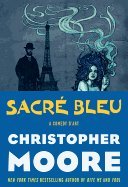Sacre Bleu: A Comedy d’Art
Begun as a history of the color blue, this book evolves into a detective romp through Montmartre, Paris, historical haunt of artists. After Vincent van Gogh allegedly shot himself, he walked a mile to seek a doctor’s help. “Why would a suicide do that?” demands Toulouse Lautrec, who decides Vincent was murdered, and begins a vigorous hunt for the culprit.
Back to the precious color blue: it is extracted from the gem lapis lazuli, available only from the wilds of Afghanistan. It was so expensive that many religious paintings of the Virgin Mary commissioned by the Catholic Church were left partially unpainted. Montmartre artists paid a better price offered by “the Colorman,” a nasty gnome-like creature with even nastier habits. But what other “price” did these great artists pay? While Renoir, Monet, Manet and Whistler were painting the light, the dark, and their lady friends having lunch, Lautrec sets out to find his friend’s murderer if he has to thread himself through all the brothels to do it!
The author begins his story with a primary color but only dips into it occasionally as his characters wander through Impressionism to a weird surrealism at the finish. Readers who enjoy bawdy, colorfully irreverent art history with a meandering mystery will enjoy the ride. Art lovers will have to content themselves with small painting reproductions throughout the book with the writer’s startling captions, and with a sober exposition in the afterword.
This book is colorful; it’s printed in blue, its language is “blue,” and the obsession with sex goes over-the-top even for Parisians of that era. There is also one egregious error with the misspelling of that time-honored English color company, Winsor & Newton. Although their art products carry the Royal Warrant (i.e., endorsed by the Royal Family), their name is not spelled “Windsor.”










